The Uffizi Gallery in Florence houses an incredible collection of art, featuring masterpieces from renowned artists like Botticelli, Raphael, Leonardo da Vinci, Michelangelo, Titian, and many others. For anyone visiting Florence, the Uffizi is undoubtedly a must-see.
However, what many visitors don’t realize is just how vast this museum really is.
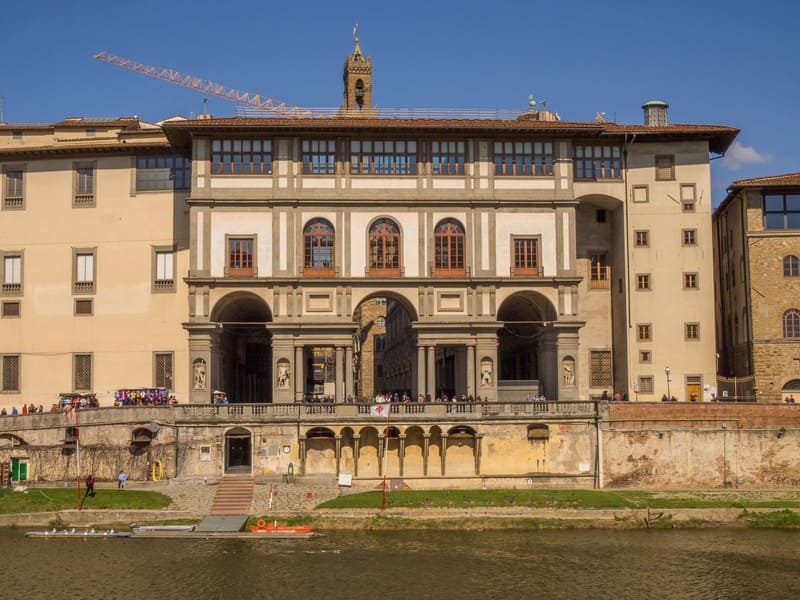
Over the years, I’ve received many requests from travelers asking for advice on how to experience the Uffizi in just an hour. While it might seem like a quick stop, trying to cover even the most important masterpieces from the museum’s collection in such a short time is nearly impossible. In reality, to fully appreciate the gallery, you’ll need at least three hours— and even then, it’s unlikely that you’ll be able to see everything.
Like many of Europe’s largest museums— the Louvre in Paris, the Rijksmuseum in Amsterdam, or the Kunsthistorisches Museum in Vienna— the Uffizi Gallery demands a careful approach. You simply cannot see everything in one go. This is where the art of selection comes into play.
So, why should you focus on only a few key pieces during your visit?
The sheer size of the collection can be overwhelming, especially after just a few rooms.
To make the most of your visit, it’s essential to plan ahead and decide which paintings you absolutely cannot miss. Among the must-sees are works by Raphael, Michelangelo, and Leonardo, which offer an unparalleled glimpse into the evolution of art. When I visited the Uffizi for the first time, I remember feeling like each room was another page from an art history textbook, filled with incredible stories and masterpieces.
Over the past few years, the Uffizi Gallery has expanded significantly. Several rooms have been restored and reopened, further enhancing the museum’s size. As a result, it now takes a great deal of time to explore every corner of the building. In fact, navigating through the museum itself requires time.
Plan to spend at least 20 minutes just getting from the entrance to the top floor, where your visit truly begins.
With such a massive collection, it’s crucial to be strategic about which works to focus on— after all, the Uffizi’s treasures are many, and you’ll want to make sure you experience the highlights without feeling rushed or overwhelmed.
What are the Uffizi Gallery’s famous paintings?
The Uffizi Gallery holds an extraordinary collection of art, with masterpieces of Medieval, Renaissance and Baroque art. While the entire gallery is a treasure trove of artistic wonders, there are a few iconic works that truly stand out and should not be missed during your visit. These masterpieces offer a window into the evolution of art, showcasing the artworks by some of the most renowned artists in history.
Whether you’re an art enthusiast or a casual visitor, these essential works will leave a lasting impression and provide a deeper understanding of the gallery’s rich heritage.
Here are the top must-see masterpieces at the Uffizi Gallery.
Uffizi Gallery famous paintings: The Maestà of Giotto
One of the first masterpieces you’ll encounter in the Uffizi is a work by Giotto, a monumental painting representing the Virgin Mary sitting gracefully on her throne with the infant Jesus in her lap, the so-called Maestà.
Created for the Ognissanti Church around 1310, this piece features some of the groundbreaking innovations introduced to painting by Giotto.
In fact, in this piece, you can observe the artist’s attempt to convey depth. The saints surrounding the Virgin are arranged in rows on both sides of her throne, with one figure placed behind another, creating the illusion of three-dimensional space. Giotto was among the first to break away from the flat, two-dimensional representations, typical for medieval art, opting instead to give his subjects a sense of volume and realism.
This early exploration of depth marked a significant step toward the more naturalistic style that would define the Renaissance.
Uffizi Gallery famous paintings: The double portrait of the Dukes of Urbino
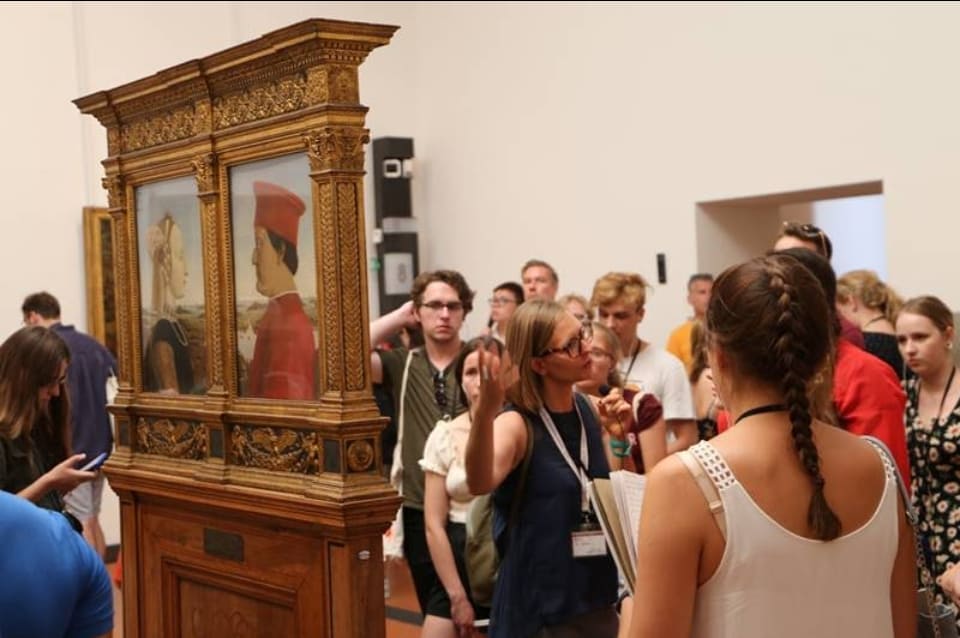
One of the most iconic masterpieces housed in the Uffizi is the stunning double portrait of the Dukes of Urbino, Federico de Montefeltro and his wife Battista Sforza, painted by Piero della Francesca in 1472. This famous portrait once adorned the audience room in the Ducal Palace of Urbino, a state ruled by Federico.
This work is significant not only for its beauty but also for the technical innovation it represents. Painted with the oil technique—newly introduced to Tuscan art at the time—it marks a pivotal moment in the history of Renaissance painting.
Piero della Francesca, influenced by the detailed, realistic style of Flemish masters like Hans Memling, masterfully captured the Dukes’ likeness. Federico’s face is portrayed with remarkable realism, showcasing his skin imperfections, wrinkles, and a broken nose—a result of an accident during a knightly tournament, which caused him to lose one of his eyes.
In the portrait, Piero chose to depict the healthy side of Federico’s face, skillfully concealing the physical imperfection, offering a flattering yet honest representation. A profile portrait constitutes a clear reference to the ancient iconography of power, given that in the Roman Empire emperors’ profiles would appear on the coins, as symbols of authority and supremacy.
In Piero della Francesca’s portrait, Federico and Battistaare shown dressed in rich, luxurious garments, with the striking contrast of dark blue and red, highlighting their status. Behind them, you can admire a breathtaking bird’s-eye view of the Duchy of Urbino, painted with a perspective that was quite unusual for the time.
Battista is adorned with exquisite jewelry,pearls, and intricately styled hair, which not only symbolize her high rank but also her purity and virtue.
Uffizi Gallery famous paintings: The Spring by Sandro Botticelli
One of the most celebrated masterpieces housed at the Uffizi Gallery is Primavera (Spring) by Sandro Botticelli. This iconic painting was commissioned by Lorenzo de’ Medici, also known as Lawrence the Magnificent, as a wedding gift for his cousin, Lorenzo di Pierfrancesco de’ Medici. The artwork is not only stunning in its visual beauty but also rich with layers of symbolism, though its precise meaning remains somewhat enigmatic.
The most widely accepted interpretation of Primavera sees it as a depiction of a lush garden in full bloom, with Venus at its center, representing the arrival of spring. This scene is often interpreted as a symbol of fertility and prosperity, making it an ideal wish for a newlywed couple.
The figures in the painting, from left to right, include Mercury, the messenger god; the three Graces, often depicted as companions of Venus; Venus herself, the central figure, accompanied by her son Cupid who floats above her head; and on the right, the mythological scene of Zephyrus, the god of the west wind, falling in love with the nymph Chloris.
In the myth, Chloris is transformed by the gods into Flora, the goddess of spring, which here is featured as an elegant lady dressed in a dress adorned with roses, a symbol of fertility and prosperity, reinforcing the painting’s theme of renewal and growth.
Primavera remains one of the most iconic works of the Italian Renaissance, blending mythology and symbolism, in a way that continues to captivate viewers today.
Uffizi Gallery famous paintings: The Birth of Venus
Another renowned masterpiece by Sandro Botticelli housed at the Uffizi is the Birth of Venus, an iconic depiction of a mythological story. The painting portrays Venus arriving on the shores of the island of Cyprus, standing delicately on a shell. She is surrounded by symbolic figures, including the allegory of Hora, who stands ready to cover Venus’s nudity with her flowing coat. Meanwhile, the two winds—Zephyrus and Aura—blow from the left, sending warm air and flowers toward the goddess to greet her and warm her as she steps onto the shore.
The Birth of Venus is also significant from a technical perspective, as it marks an experiment for Botticelli. The composition is painted on canvas, a medium that was still relatively uncommon during the period when most artists typically worked on wooden panels.
Interestingly, this masterpiece was once part of the private collection of Lorenzo di Pierfrancesco de Medici, the same man who also owned Botticelli’s Primavera.
Uffizi Gallery famous paintings: Leonardo da Vinci’s Annunciation
Within the Uffizi Gallery’s exceptional collection, you’ll find two fully autographed paintings by none other than Leonardo da Vinci. The first is his early Annunciation, painted at the beginning of his career.
One of the most striking features of the painting is the stunning landscape that stretches behind the figures. The view includes a distant, almost ethereal portrayal of mountains veiled by a soft, hazy whiteness on the horizon. This is an example of Leonardo’s use of aerial perspective, a technique he began to introduce in his art, to reinforce the realism in the depiction of depth and distance.
The figure of the the Archangel Gabriel, in this painting also reveals Leonardo’s early fascination with flight. The angel’s large wings—reminiscent of an eagle or another majestic bird—reflect the artist’s ongoing research into the mechanics of flight, a topic that would capture his attention throughout his life.
The Annunciation is a good example of Leonardo’s experimentation and early mastery in blending artistic innovation with the exploration of nature and science.
Uffizi Gallery famous paintings: da Vinci’s Adoration of the Magi
In addition to the Annunciation, visitors to the Uffizi Gallery can also admire Leonardo da Vinci’s unfinished Adoration of the Magi. This painting was commissioned by the friars of San Donato a Scopeto Monastery but the panel remained incomplete becauses of Leonardo’s departure from Florence.
In 1482, the artist left Florence to take up a position at the court of Duke Ludovico Sforza in Milan, marking the end of his work on this piece.
Despite its unfinished state, the Adoration of the Magi is one of the most fascinating works in the Uffizi collection. It offers a rare glimpse into Leonardo’s creative process, allowing viewers to observe his underdrawings and underpainting. These layers reveal how Leonardo worked to describe the volumes and depth of his figures.
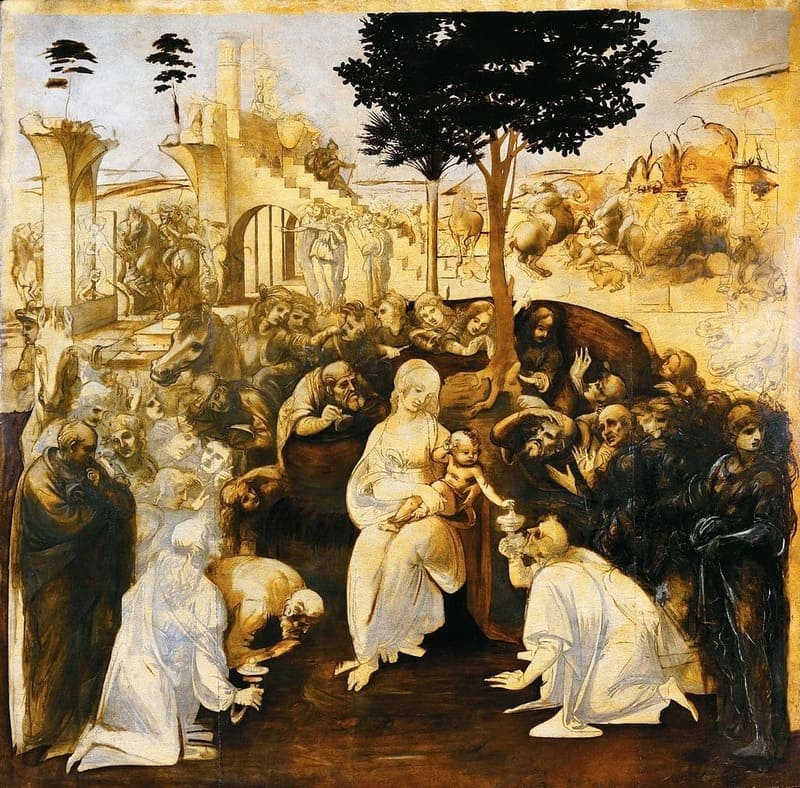
In several areas of the painting, you can see his experiments with new ideas and compositions. For example, on the right side, there are sketches of four different horse heads, some of which may never have been intended for the final piece.
Viewing this unfinished painting feels like stepping back in time to observe Leonardo at work, making it an incredibly engaging experience for art lovers and history enthusiasts alike. The Uffizi not only preserves this masterpiece but also offers a window into the mind of one of the greatest artists in history.
Uffizi Gallery famous paintings: Tondo Doni
Among the works housed in the Uffizi Gallery, one of the most striking is Michelangelo’s Tondo Doni, a panel painting created for the Doni family.
This Tondo commemorates the birth of Doni’s first daughter, born in 1506. At the center of the scene, the Holy Family is depicted in a powerful and dynamic composition. The Virgin Mary is shown turning to take baby Jesus from the hands of St. Joseph, and the entire scene is filled with the characteristic twisting torsion that Michelangelo is known for.
What makes this painting particularly unique is Michelangelo’s bold use of color. The bright, intense hues—pinks, oranges, and greens—revolutionized the use of colour in Renaissance painting. Through this work, Michelangelo redefined colours’ role in artistic expression, adding a vibrancy that was unseen before.
In the background of the Tondo Doni, we see the figure of young St. John the Baptist. Behind him, four naked men are seated. Art historians are unsure of their precise meaning, but one hypothesis is that they represent the souls of the Doni family’s lost children. Before their daughter was born, Magdalena Doni had suffered four miscarriages, and these figures could be symbolic representations of all of their children, the four who did non survive and their daughter born in 1506.
The Tondo Doni thus holds both artistic and emotional significance, capturing a moment of familial joy while also reflecting a deep personal history for the Doni family.
Uffizi Gallery famous paintings: Madonna with the Goldfinch
One of Raphael’s most celebrated masterpieces, Madonna with the Goldfinch, captures the early stages of the artist’s career around 1506. At the time, Raphael was in Florence, immersing himself in the artistic influences of Michelangelo and Leonardo da Vinci. This work is part of his famed “Sweet Madonnas” series, known for their gentle, tender portrayal of the Virgin Mary.
In the painting, the Virgin Mary is seated on a rock in the midst of a tranquil, idyllic landscape. While she attempts to read, her attention is divided between two young boys—baby Jesus and St. John the Baptist—who are playfully interacting with a goldfinch.
The bird, in medieval symbolism, represents the Passion of Christ. Legend holds that a goldfinch flew to Jesus while he was on the cross, staining its head with a drop of his blood, thus linking the bird to Christ’s suffering and sacrifice.
The history of this painting is as fascinating as its symbolism. Over the centuries, Madonna with the Goldfinch endured significant damage. During the 16th century, the palace where it hung was destroyed in a landslide, causing the panel to break into numerous pieces.
The painting was then glued together and repainted multiple times in an attempt to restore it. It wasn’t until 2009 that modern restoration techniques could finally undo the previous work, carefully removing the layers of repaint and consolidating the artwork. Thanks to this meticulous restoration, visitors today can experience the Madonna with the Goldfinch appreciating its beauty and harmony once again.
The story of this painting, from its creation to its restoration, is an example of the intriguing fate of the Renaissance masterpieces, making it an essential piece to admire during your visit to the Uffizi Gallery.
Uffizi Gallery famous paintings: Portrait of Eleonora di Toledo
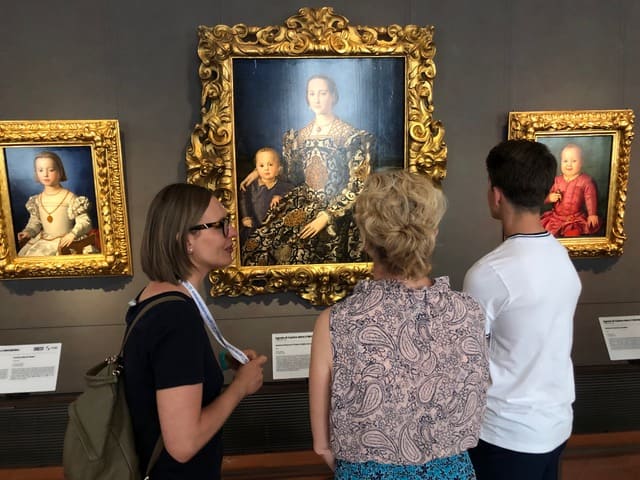
A must-see masterpiece in the Uffizi Gallery is the striking portrait of Eleonora de Toledo, painted in 1545 by the renowned Medici portrait painter Agnolo di Cosimo called Bronzino. This stunning painting is famous for its remarkable attention to detail, particularly in the depiction of Eleonora’s dress.
However, there’s an interesting twist to the story—the dress she is shown wearing never actually existed. Bronzino was given only a small piece of textile woven at the Florentine ducal factories, showcasing beautiful fabric. From this modest piece, the artist had to invent the entire gown, creating a vision of luxury that never truly materialized.
The painted dress served not only as a portrayal of the Duchess’s elegance but also as a marketing tool for the Florentine textile industry. Copies of this painting were sent across Europe, reaching the most influential courts. Cosimo de’ Medici, Eleonora’s husband, hoped these copies would spark interest among aristocrats, encouraging them to purchase Florentine-made garments and emulate the opulence of the Medici family.
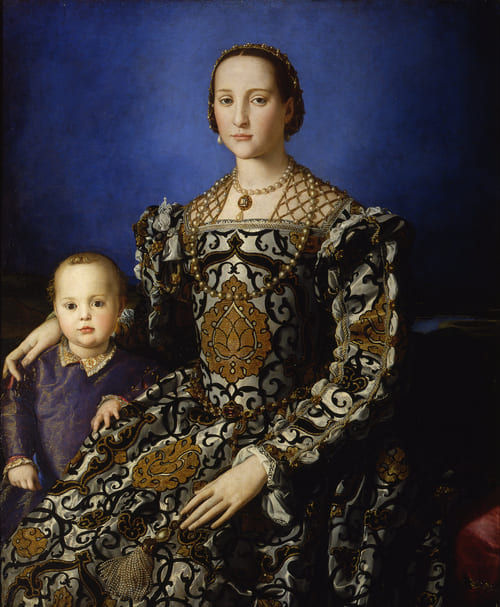
Eleonora de Toledo herself was a powerful and influential figure in Renaissance Florence. As a mother of nine children with Cosimo, she ensured the succession of the Medici family line. Her intelligence and wealth allowed her to play a key role in the governance of Florence. Notably, she was instrumental in acquiring the Pitti Palace and overseeing the construction of the Boboli Gardens, which remain iconic symbols of Florentine grandeur. She also managed the family’s vast estates outside the city, securing their financial power.
In Bronzino’s portrait, Eleonora is glorified not only as a powerful political figure but also as a mother, depicted here with her second-born son, Giovanni de’ Medici, who was destined for an ecclesiastical career.
This portrait encapsulates both the personal strength and the political influence of Eleonora de Toledo, making it a fascinating work to explore during your visit to the Uffizi Gallery.
Uffizi Gallery famous paintings: Venus of Urbino
Another iconic masterpiece you’ll encounter at the Uffizi Gallery is Titian’s Venus of Urbino, a sensual and symbolic painting created in 1538 by this renowned Venetian artist for Guidobaldo Della Rovere, heir to the Duchy of Urbino.
The painting portrays a nude woman reclining confidently on a bed in an elegant domestic setting, while two maids in the background prepare her garments, suggesting an atmosphere of everyday intimacy and luxury.
This provocative yet refined composition is widely believed to have been commissioned to commemorate the marriage of Guidobaldo to his young bride, Giulia Varano, just a few years prior. Beyond its surface beauty, Venus of Urbino is interpreted as an allegory of marital love and domestic virtue. It may have served as an instructional image—a kind of visual guide—for Giulia’s role as wife and future mother within the powerful Della Rovere family.
Titian subtly weaves deeper meanings into the painting through symbolic colour and iconography. The green curtain likely symbolizes hope, the white linens suggest faith, and the red of the mattress alludes to charity—three traditional female virtues.
A small dog resting peacefully at the figure’s feet is a classic symbol of loyalty and marital fidelity. Meanwhile, the subject’s nudity is not merely erotic; it signifies the sexual and reproductive responsibilities of a noble wife—underscoring her role in securing dynastic continuity through childbirth.
Venus of Urbino remains one of the Uffizi’s most discussed and debated works, embodying the Renaissance’s ability to blend sensual beauty with intellectual and symbolic depth. It’s a painting that continues to captivate visitors and provoke thoughtful interpretation.
Uffizi Gallery famous paintings: The Shield with the Head of Medusa
Among the most striking works housed in the Uffizi Gallery in Florence is an object that challenges the traditional idea of a “painting”: the Shield with the Head of Medusa, created by Caravaggio around 1597.
This painting on a shield, commissioned by Cardinal Francesco Maria del Monte—one of Caravaggio’s earliest and most influential patrons—was conceived as a gift for Ferdinando I de’ Medici, Grand Duke of Tuscany.
The piece serves a dual purpose: it is both a masterful work of art and a sophisticated intellectual game rooted in classical mythology.
According to myth, Perseus, after decapitating the fearsome Medusa, offered her head to the goddess Athena, who affixed it to her shield, transforming it into a powerful and terrifying weapon. Caravaggio draws on this myth and, with his raw and theatrical realism, depicts Medusa at the very moment of her decapitation—her eyes wide open, mouth frozen in a silent scream, and serpents writhing in her hair.
The painting is striking for its dramatic intensity and its unusual format: not a canvas or a wooden panel, but a real convex shield, as if it were truly meant to be wielded in battle.
Fittingly, the Medici did not store the work with their paintings, but rather in their armory, alongside swords and armor—as both a symbolic weapon and an artistic masterpiece.
Today, this captivating creation is on display at the Uffizi Gallery as one of the most original expressions of Caravaggio’s genius—an artwork that fuses art, myth, and dynastic politics into a single, visually arresting statement.
Uffizi Gallery famous paintings: Caravaggio’s Bacchus
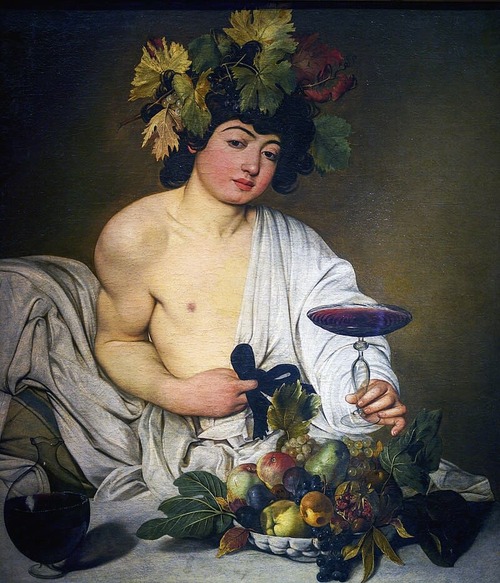
One of the Uffizi Gallery’s most intriguing masterpieces is Caravaggio’s Bacchus, a work that remained hidden from public view for centuries. Likely commissioned around 1596 by Caravaggio’s powerful patron, Cardinal Francesco Maria del Monte, the painting mysteriously disappeared from display and was only rediscovered in the museum’s storage rooms in 1913. It’s widely believed that the Medici family censored the piece due to its bold sensuality and provocative tone.
Unlike traditional mythological portrayals of the god of wine, Caravaggio’s Bacchus is unapologetically human and intimate. The figure is not some distant deity, but a young man—Caravaggio’s friend and frequent model, Mario Minniti—draped in a loosely worn toga, with grape leaves woven through his tousled hair. His cheeks are flushed, his gaze inviting, and he leans forward to offer the viewer a glass of wine. His red-stained fingers suggest he’s already indulged, and his half-naked body exudes a raw, almost palpable sensuality.
This portrayal likely struck the Medici court as too suggestive.
Far from the heroic or idealized gods typical of Renaissance art, Caravaggio’s Bacchus is flesh and blood—youthful, vulnerable, and temptingly real. It’s easy to see why such an image might have challenged the era’s sense of decorum.
Adding a layer of intellectual play, Caravaggio even includes a hidden self-portrait in the reflection of the wine carafe at the lower left of the canvas. Look closely and you’ll spot the faint image of the artist himself, wearing a black hat—an intimate wink from the master who often inserted himself into his own mythologies.
Today, Bacchus stands proudly among the Uffizi’s most admired works. It’s not just a celebration of wine and youth—it’s a daring statement on pleasure, identity, and the blurred lines between divine myth and human experience.
Don’t miss the chance to see this fascinating painting up close on your visit to the Uffizi!
(Less) famous paintings to see at the Uffizi Gallery (if you have extra time)
If you’re looking to extend your visit, the medieval rooms hold some truly exceptional works of art that are not to be missed. Among them is the exquisite Annunciation by Simone Martini, a prime example of Gothic art. The painting is remarkably well-preserved, showcasing intricate details, especially in the textiles around the figures. The almost Scottish-patterned fabric draped over the Archangel Gabriel is particularly striking. This masterpiece is a perfect representation of the International Gothic style, which gained prominence in the 14th century.
Another standout is the Adoration of the Magi by Gentile da Fabriano. This piece was commissioned by Palla Strozzi, the wealthiest man in Florence during the early 15th century, and it is a reflection of his ambition for power. Created for Palla’s private chapel in Santa Trinita Church, the painting features Palla himself, almost positioned as one of the Magi, standing directly behind the youngest Magus, who adores the newborn Jesus. The painting exudes opulence, with abundant use of gold and precious stones—though many of these gems have sadly disappeared over time. Palla’s attempt to challenge the Medici family’s influence in Florence ultimately led to his exile, while the Medici took control of the city in 1434.
In the same room housing Michelangelo’s Tondo Doni, you can find portraits of the Doni couple, Angelo and Maddalena, painted by Raphael. Maddalena’s portrayal is strongly influenced by Leonardo’s Mona Lisa, as between 1505 and 1506, when this portrait was made, young Raphael was closely studying the works of both Leonardo and Michelangelo in Florence. The couple is depicted in luxurious attire, with Maddalena wearing a stunning pendant—a wedding gift from Angelo. The pendant, set with precious stones: ruby, sapphire, and emerald, symbolizes vitality, wealth and purity of the lady.
On the first floor of the gallery, in the rooms dedicated to late Renaissance art, you’ll encounter Parmigianino’s Madonna with a Long Neck. This masterpiece exemplifies Mannerism, the final phase of the Renaissance. Commissioned in 1534 by Elena Baiardi Tagliaferri for Tagliaferri Chapel in Santa Maria dei Servi church in Parma, the painting was left unfinished after Parmigianino’s move to Casalmaggiore and his death in 1540. Despite its incomplete nature, it beautifully showcases the exaggerated proportions characteristic of Mannerist art, such as Madonna’s unnaturally long neck and hips. The depiction of the infant Jesus, resembling a lifeless Christ, also echoes Michelangelo’s Pietà in St. Peter’s Basilica, marking a shift from the more naturalistic style of earlier Renaissance works.
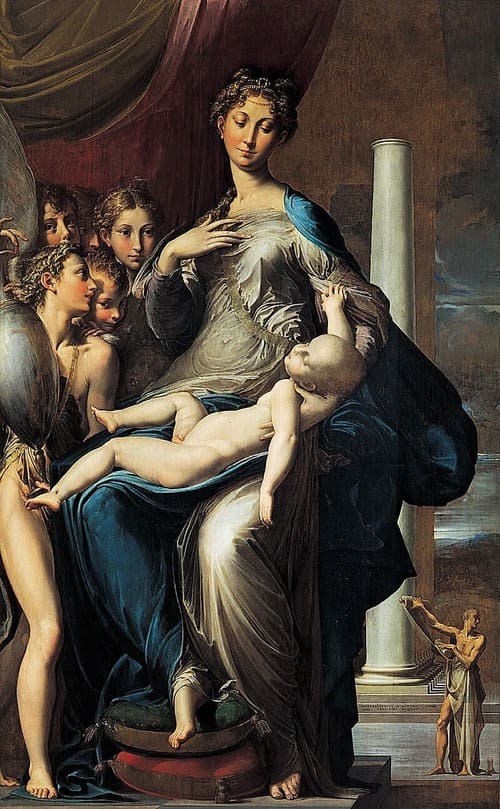
Finally, in the rooms dedicated to Baroque art, you’ll find Artemisia Gentileschi’s dramatic Judith Slaying Holofernes, painted in 1620. This powerful work depicts Judith beheading the Assyrian general Holofernes, capturing the moment with intense realism. Artemisia, one of the most important female Baroque artists, often portrayed strong and determined women in her works, and Judith is no exception. She is shown as confident and resolute, carrying out her mission without hesitation. Due to its violent imagery, the painting was initially tucked away in a corner of the Uffizi Gallery and was only recently put back on display. It’s a must-see for anyone interested in the raw emotional power of Baroque art.
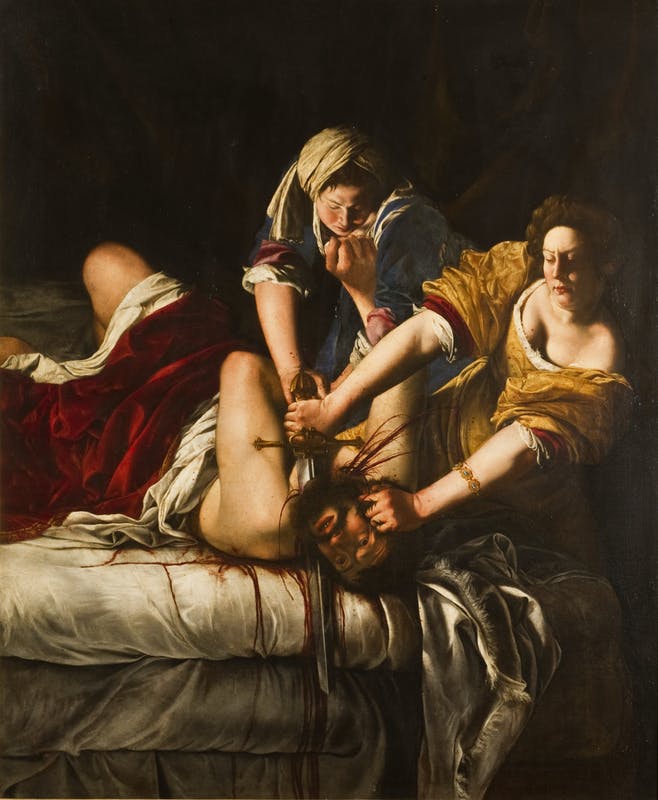
Uffizi Gallery famous paintings: visitor information
- Opening hours: From Tuesday to Sunday, 8.15 am to 6.30pm
- Closed on Mondays, 1 January, 25 December
- On the first Sunday of the month the entrance is free of charge but without the possibility to book a timed entrance.
- The ticket office closes 5.30pm
- Tickets:
- Single ticket for the Gallery only:
- adults: 25€ (+4 € for booking)
- discounted ticket for the timeslots 8:15, 8:30 and 8:45 am: 19 € (+4 € for booking)
- EU youths 18-25 years old: 2 € (+4€ for booking)
- under 18: free (+4 € booking)
- Uffizi with the visit at the Vasari Corridor:
- adult: 47,00 €
- EU youths 18-25 years old: 6,00 €
- Under 18: 4,00 €
- Passepartout 5 days:
- Single ticket for 5 consecutive days for Uffizi, Pitti Palace and the Boboli Gardens:
- Adult: 40€ – Including Vasari Corridor: 58€
- Under 18: 4€
- Single ticket for 5 consecutive days for Uffizi, Pitti Palace and the Boboli Gardens:
- Single ticket for the Gallery only:
- Suggested duration of the visit: 2-3 hours.
- Official ticket office for the state museums in Florence.
- Visitors’ map.
If you’re planning a trip to Florence and are in search of a professional guide, contact us!
We are happy to organize your museum visits and cultural tours to make your stay truly unforgettable.


